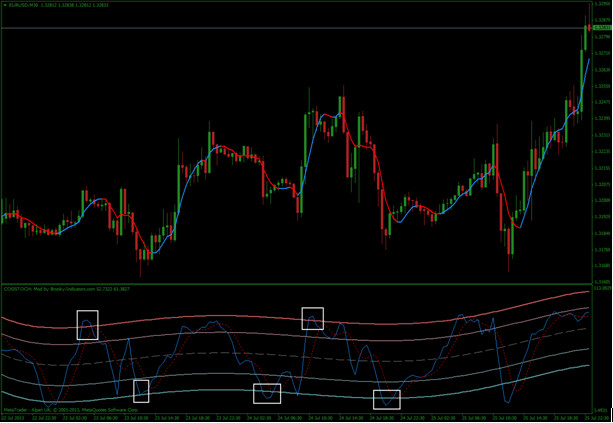CogStochastic Binary Options Strategy – Newbies Approved
CoGStochastic and FX Trend Binary Options strategy
Although the website where I found this strategy indicated that it is used for Binary Options trading, the author talks about Stop Loss and Take Profit levels which are used in Forex so I believe it is a Forex strategy but it’s easily adaptable to Binary Options, just like almost any other strategy. By the way, the website where I found it is www.forexstrategiesresources.com and the author is JamesUK. To be honest, I still haven’t decided if it’s an easy to use strategy or complicated one, but since it only uses 2 indicators, I guess it can’t be that hard to apply. So let’s learn more about it:
How to use the CoGStochastic and FX Trend Strategy
For this one you will need two indicators, both available at the end of this article and on our Forum. The first indicator is the CoGStochastic (Download at the bottom of page) and although the author doesn’t explain what exactly that is, let me give you a crash course about it: CoG stands for Center of Gravity and it’s a relatively well known custom indicator which measures the distance that price deviates from the mean. Price always returns to the mean due to the “rubber band” effect so when it deviated too much, it must return. The “too much” part is measured by the Center of Gravity so when the Stochastic moves away from the mean (that’s the center dotted line on the chart) and touches the outer bands (whether it’s the top or the bottom one), it will return to the center line. In other words, this is a different way of looking at the overbought or oversold condition of the Stochastic. Here’s how the indicator looks like on a chart:

Notice the white rectangles: those are zones where the Stochastic Oscillator was overbought or oversold (there are other zones which I did not mark on the chart) and was too far away from the mean (middle dotted line). Price’s next move was to reverse the current direction and return to the mean. But if you take a closer look at the picture, you will see that price doesn’t return immediately; that’s where the FX Trend indicator comes into play (Download at the bottom of page): after the Stochastic returns from the outer bands of the CoG, we wait for a matching color change on the FX Trend indicator (Red and Blue line on price) and we enter our trade accordingly.
Put Entry:
- Stochastic crosses downwards the upper Red line of the CoG
- FX Trend changes to Red
Call Entry:
- Stochastic crosses upwards the lower Blue line of the CoG
- FX Trend changes to Green
Why the CoGStochastic Strategy doesn’t Suck?
I told you I can’t decide whether this strategy is easy or complicated; and look at the rules: they are pretty simple and straightforward, but all the Center of Gravity and mean reversion stuff can get confusing to a newbie. Anyway, considering that a new and inexperienced guy can trade a mean reversion strategy using just two simple rules is what makes this strategy not suck.
Why does the CoGStochastic Strategy Suck?
As much as I like the principle behind it, I cannot help but notice the fact that it generates a lot of bad signals. I believe the reason for that is the FX Trend indicator so I would definitely replace it if I was to use this strategy. Or at least I would change its settings to make it less choppy because in my opinion, it changes colors too fast and this generates the bad signals I talked about. Another thing is that we don’t have clear rules about expiry times: the author says it should be used on a 30 minute time frame but doesn’t tell us anything about expiries. Most of the signals work eventually but a long expiry time is needed. If you experiment with this strategy, let us know on the Forum which expiry works best.
Wrapping it up – Could be OK for Beginners
The CoGStochastic strategy is easy to pick up and trade by newbies, even if they don’t understand the whole principle behind it. From that point of view, the strategy is OK, but I don’t think the results will be spectacular. In order to improve it, the FX Trend indicator must be replaced or tweaked and that goes for the CoGStochastic indicator too. A more experienced trader will be able to modify the settings and probably get better results, but overall, I think this strategy has value for newbies and seasoned traders alike and it has a lot of potential, especially with the modifications I talked about.